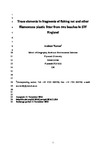Trace elements in fragments of fishing net and other filamentous plastic litter from two beaches in SW England
| dc.contributor.author | Turner, Andrew | |
| dc.date.accessioned | 2017-03-30T14:01:31Z | |
| dc.date.available | 2017-03-30T14:01:31Z | |
| dc.date.issued | 2017-05 | |
| dc.identifier.issn | 0269-7491 | |
| dc.identifier.issn | 1873-6424 | |
| dc.identifier.uri | http://hdl.handle.net/10026.1/8745 | |
| dc.description.abstract |
Filamentous plastic litter collected from two beaches in south west England has been characterized by FTIR and XRF. The majority of samples were constructed of polyethylene and consisted of twisted or braided strands of a variety of colours that appeared to be derived from commercial fishing nets. A number of different elements were detected among the samples but, from an environmental perspective, the regular occurrence of Cr and Pb and the occasional or isolated occurrence of Br, Cd and Se were of greatest concern. The highest total concentrations of Br (2420 μg g-1), Cd (1460 μg g-1), Cr (909 μg g-1), Pb (3770 μg g-1) and Se (240 μg g-1) were always encountered among orange samples and are attributed to the presence of lead chromates and cadmium sulphoselenide as colourants and to brominated compounds as flame retardants. Element bioaccessibility was evaluated by ICP-MS following an acidic extraction test that mimics the digestive tract of seabirds, with maximum values after a seven-day incubation period and relative to respective total concentrations of 0.2-0.4% for Cd, Cr and Pb and about 7% for Br. In addition to the well-documented impacts on wildlife through entrapment, filamentous plastic waste may act as a significant source of hazardous chemicals into the marine foodchain through ingestion. | |
| dc.format.extent | 722-728 | |
| dc.format.medium | Print-Electronic | |
| dc.language | en | |
| dc.language.iso | en | |
| dc.publisher | Elsevier BV | |
| dc.subject | Filamentous plastic litter | |
| dc.subject | Fishing gear | |
| dc.subject | FP-XRF | |
| dc.subject | Heavy metals | |
| dc.subject | Bromine | |
| dc.subject | Seabirds | |
| dc.title | Trace elements in fragments of fishing net and other filamentous plastic litter from two beaches in SW England | |
| dc.type | journal-article | |
| dc.type | Journal Article | |
| plymouth.author-url | https://www.webofscience.com/api/gateway?GWVersion=2&SrcApp=PARTNER_APP&SrcAuth=LinksAMR&KeyUT=WOS:000399261400075&DestLinkType=FullRecord&DestApp=ALL_WOS&UsrCustomerID=11bb513d99f797142bcfeffcc58ea008 | |
| plymouth.issue | Mar. Pollut. Bull. 111 2016 | |
| plymouth.volume | 224 | |
| plymouth.publication-status | Published | |
| plymouth.journal | Environmental Pollution | |
| dc.identifier.doi | 10.1016/j.envpol.2016.11.034 | |
| plymouth.organisational-group | /Plymouth | |
| plymouth.organisational-group | /Plymouth/Faculty of Science and Engineering | |
| plymouth.organisational-group | /Plymouth/Faculty of Science and Engineering/School of Geography, Earth and Environmental Sciences | |
| plymouth.organisational-group | /Plymouth/REF 2021 Researchers by UoA | |
| plymouth.organisational-group | /Plymouth/REF 2021 Researchers by UoA/UoA07 Earth Systems and Environmental Sciences | |
| plymouth.organisational-group | /Plymouth/Research Groups | |
| plymouth.organisational-group | /Plymouth/Research Groups/BEACh | |
| plymouth.organisational-group | /Plymouth/Research Groups/Marine Institute | |
| plymouth.organisational-group | /Plymouth/Users by role | |
| plymouth.organisational-group | /Plymouth/Users by role/Academics | |
| dc.publisher.place | England | |
| dcterms.dateAccepted | 2016-11-11 | |
| dc.rights.embargodate | 2018-2-13 | |
| dc.identifier.eissn | 1873-6424 | |
| dc.rights.embargoperiod | Not known | |
| rioxxterms.versionofrecord | 10.1016/j.envpol.2016.11.034 | |
| rioxxterms.licenseref.uri | http://www.rioxx.net/licenses/all-rights-reserved | |
| rioxxterms.licenseref.startdate | 2017-05 | |
| rioxxterms.type | Journal Article/Review |


